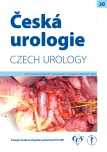ROBOT-ASSISTED PARTIAL NEPHRECTOMY
Authors:
Vladimír Študent ml.; Igor Hartmann; Aleš Vidlář; Michal Grepl; Vladimír Študent
Authors‘ workplace:
Urologická klinika LF UP a FN Olomouc
Published in:
Ces Urol 2016; 20(1): 13-15
Category:
Video
Overview
Introduction:
In this video we present our experience with robot-assisted partial nephrectomy (RAPN).
Material:
Between June 2010 and June 2015, we performed 85 RAPNs. Our first experience with minimally invasive partial nephrectomy dates back to 2005, when we did our first laparoscopic resection (since that time more than 120 laparoscopic partials were done). The number of patients treated is still growing due to the increasing number of small renal masses detected and our increasing experience with more advanced tumours (size and location). We are now able to resect even some unpleasantly located kidney tumours.
Our technique:
Partial nephrectomies were done using 2nd generation DaVinci® S™ system. We are performing transperitoneal approach with 4–5 ports and standard patient positioning (flank position, slightly bent). We start with open access for the 12mm camera port. Then we use two 8mm ports for the robotic arms and 12mm and sometimes another 5mm port for the assistant. The abdomen is insufflated with CO2 to 12 mmHg. We mobilise the colon, open Gerota fascia and remove the perirenal fat to expose the tumour. The tumour margins are identified using ultrasound. They are then scored circumferentially by electro cautery. Then we prepare the renal hilum. A vessel loop is put around the renal artery, which is then clamped using a bull dock. We do not usually do selective clamping. But in selected cases (small tumour, favourable location) we resect the kidney without clamping the artery (zero ischemia). Dissection of the tumour is done using blunt and sharp technique. Electro cautery is not used, for it would impair the visual control. The tumour is placed in an endobag. We then use plasma argon coagulation for the resected margin. The resected kidney is closed in two layers. We start with braided absorbable Safil 3–0 suture with a knot and clip at one end. This suture goes from outside in, several turns are done to close the major vessels or calices, then it goes out so another clip can be placed at the end and the suture tightened. The second suture is done using sliding clips technique. Haemostatic agents are used if necessary. We also try to close the Gerota fascia. At the end we always place a Redon drain. Urinary catheter is removed on the first post-operative day. Surgery is performed under standard general anaesthesia with commonly used postoperative analgesics.
Results:
Mean console time was 59 min (45–120 min), warm ischemia time was 12 min, in 30 cases there was zero ischemia time. This could be done due to small size and favourable location of the tumour. Mean blood loss was 120 ml (20–300 ml). There were no conversions to open surgery and there were no major complications requiring surgery (Clavien IIIb). In 2 cases we had to insert DJ stent due to urinoma (Clavien IIIa). RCC was found in 82 cases and in 3 cases oncocytoma. The mean size of the tumour was 3.9 cm (1.5–10 cm). The surgical margins were negative in all cases, and so far there has been no relapse of tumour. Conclusion: RAPN showed very good results, enhanced the visual control and manoeuvrability, thus extending the number of tumours that can be managed using minimally invasive technique. Using the novel techniques (sliding clips) both warm time ischemia and complication rates can be reduced.
KEY WORDS:
Kidney tumour, Renal cell carcinoma, partial nephrectomy, robot-assisted partial nephrectomy.
Labels
Paediatric urologist Nephrology UrologyArticle was published in
Czech Urology

2016 Issue 1
Most read in this issue
- THE USE OF SHOCK WAVES IN THE TREATMENT OF ERECTILE DYSFUNCTION
- HORSESHOE KIDNEY TRAUMA
- 18-F CHOLINE PET CT IN PRIMARY DIAGNOSIS OF THE PROSTATE CANCER
- NEUROSTIMULATION AND NEUROMODULATION IN THE CHILDHOOD
